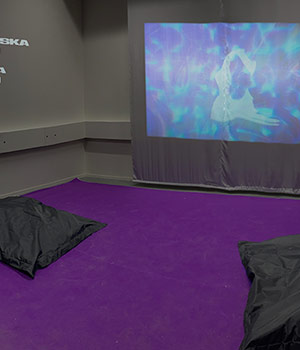Our first encounter with the students from the master’s programme in Visual Communication left quite an impression on us. They stood around the table and talked about their core values regarding inclusivity, plurality and equity. In a place where we found so much division and separation, we felt unity and a common desire among the students to shape the world around them anew.
These students were ready to give us much more than information or messages; they were ready to tell stories of reorientation, to lead us to the things that are out of our reach, to encourage us to be open to them, to shape them and be shaped by them.
Family histories, the many “becomings” of people who identify as female, chronic pain, burning ecological questions, matters of cultural translation and language, privacy and identity to name a few, unfold rich and generous in front of our eyes. The stories of the humans involved, along with other forms of life evoked, are entangled and entwined like the roots of trees. First images, sketches, notes, models grow into full scale, well-thought, detail oriented projects that dialogue and reflect on their collective (un) learning process.
But even more, these stories are not simply seen, they are sensed. Our fingers follow the lines of the newly-brought-in-the-world typefaces, our eyes impatiently watch the videos, our bodies enter and are immersed in the environment, our hands participate in making our own drawings or binding publications. In order to be reoriented, we need to reconnect. The Visual Communication students find the courage to create spaces to enjoy now, a radical act in a world that rejects any action it cannot make a profit from.
Yours,
Matilda Kästel & Eleni Riga , CuratorLab
Our first encounter with the students from the master’s programme in Visual Communication left quite an impression on us. They stood around the table and talked about their core values regarding inclusivity, plurality and equity. In a place where we found so much division and separation, we felt unity and a common desire among the students to shape the world around them anew.
These students were ready to give us much more than information or messages; they were ready to tell stories of reorientation, to lead us to the things that are out of our reach, to encourage us to be open to them, to shape them and be shaped by them.
Family histories, the many “becomings” of people who identify as female, chronic pain, burning ecological questions, matters of cultural translation and language, privacy and identity to name a few, unfold rich and generous in front of our eyes. The stories of the humans involved, along with other forms of life evoked, are entangled and entwined like the roots of trees. First images, sketches, notes, models grow into full scale, well-thought, detail oriented projects that dialogue and reflect on their collective (un) learning process.
But even more, these stories are not simply seen, they are sensed. Our fingers follow the lines of the newly-brought-in-the-world typefaces, our eyes impatiently watch the videos, our bodies enter and are immersed in the environment, our hands participate in making our own drawings or binding publications. In order to be reoriented, we need to reconnect. The Visual Communication students find the courage to create spaces to enjoy now, a radical act in a world that rejects any action it cannot make a profit from.
Yours,
Matilda Kästel & Eleni Riga , CuratorLab















